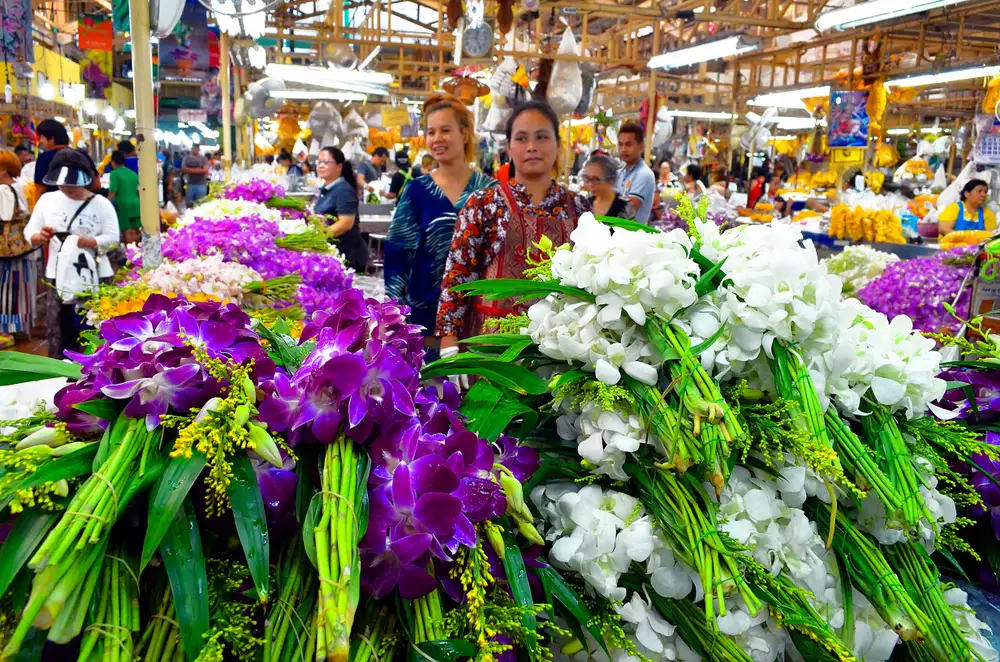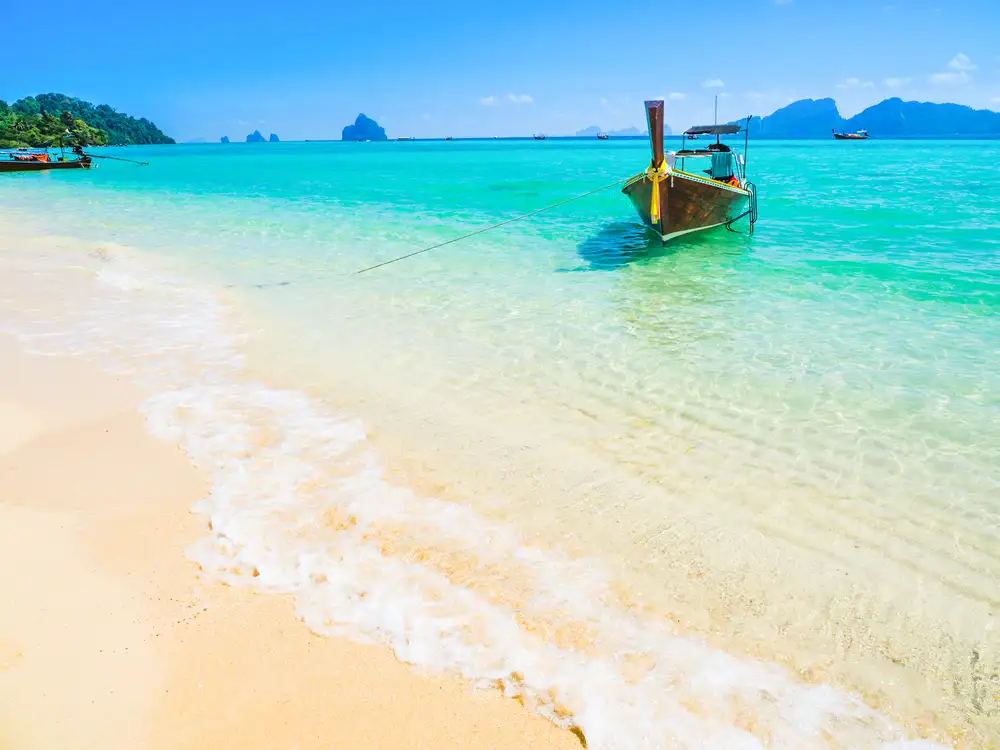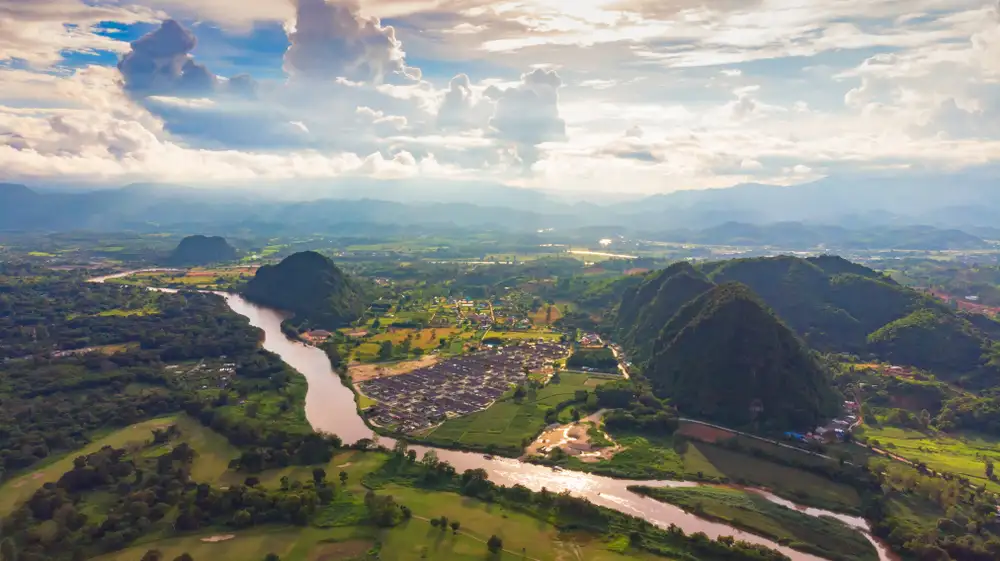Thailand sees millions of visitors every year, so it’s no surprise that almost anywhere you go, you’ll encounter a crowd, from the beach bunnies of Phuket to the bustling masses in Bangkok. But the crowds don’t preclude a truly authentic Thai vacation. Some of the nation’s best sights are far from cities, tucked into rural inland provinces or Treasure Island-like atolls afloat in the Andaman Sea. All it takes to experience them? A sense of adventure and a few baht for transportation.
Here are some of the country’s best-kept secrets, whether you are backpacking on a buck a day or embarking on a luxurious journey.
Additional reporting by Megan Johnson
Planning Your Visit
Best Time to Visit: November to March offers these destinations the most favorable weather conditions, with lower humidity and minimal rainfall.
Getting Around:
- Domestic flights connect major cities
- Train services run between Bangkok and Chiang Rai
- Local buses and minivans provide economical transportation
- Rental motorbikes are available in most locations
Nakhon Si Thammarat
Nakhon Si Thammarat, or simply Nakhon to locals, may not look like a destination in and of itself. It’s a small, unprepossessing city without world-class restaurants or postcard-perfect beaches—at least at first. But look again. One of Thailand’s oldest and most important temples (or wats) is home here. UNESCO designates Wat Phra Mahathat Woramahawihan a World Heritage site for its early 13th-century architecture and massive scarlet pagoda. A quick tour costs just a handful of baht.
Elsewhere in Nakhon, a shadow-puppet theater provides family-friendly diversion, and in the waters off the small district of Khanom, pink dolphins can be spotted on a boat tour (yes, they are bubblegum-pink!). Of course, this being Thailand, there are gastronomic gems to be uncovered. Kopi, a local Nakhon chain, dishes out the best Thai iced coffee and steamed buns in southern Thailand; I am only half kidding when I suggest the iced coffee is worth the drive alone.
Where to Stay: Twin Lotus Hotel
Bangkok’s Best Markets

Pak Klong Talad Flower Market
Best visiting hours: 3 AM – noon
When visitors want Bangkok’s best street food, they flock to the wobbly metal tables and busy food stands of Soi 38. But the heavily trafficked district is not the only game in town. The Pak Klong Talad flower market is a favorite for its colorful mounds of flowers, fruits, and vegetables and for its food sellers. Amid tables piled high with orchids and marigolds, food vendors serve spicy papaya salad, pad thai, sweet confections, and other dishes.
Bang Nam Pheung Floating Market
Operating hours: Weekends, 8 AM – 2 PM
Another oft-missed must-do is the Bang Nam Pheung floating market on the city’s eastern outskirts. It’s smaller and more low-key than other floating markets frequented by travelers, with just a few traditional boats bobbing along the Chao Phraya under a velvety green canopy of trees. Here, among locals, sample smelly jackfruit or a strange, spiky gac fruit. You will feel like you’re in a traditional Thai village despite the noise and crowds just a few miles west.
Where to Stay: Bangkok Tree House
This eco-friendly hotel on the river is in close proximity to Bang Nam Pheung, and features a rooftop terrace, an on-site restaurant, and rooms that feature balconies or patios.
Andaman Coast Kohs

Best time to visit: November to April (Dry season)
Once a backpacker’s backwater of deserted beaches and cheap huts for rent, however, the Andaman Islands are now both posh and very popular. But they’re well worth your time, especially on a day trip, and they’re far less frequented than Phuket and Koh Phi Phi to the north. Some of these tiny islands are inhabited, but most are not.
From Pak Meng Pier, set off on a tour of the small karsts, or limestone formations that rise steeply out of the sea. Snorkel around the outer fringes of Koh Kradan or Koh Mook, where schools of tropical fish trawl the vibrant fan corals. Watch out for spiny sea urchins that tuck themselves into the shallows. At Koh Ngai, find a small resort and a stretch of white sand facing out to the sea. Colorful longtail boats floating on the glassy sea are one of many Instagram-worthy moments just waiting to be captured.
Finally, ask your captain to stop at Morakot Cave, (the Emerald Cave). Don a swimsuit and life jacket (if you’re not a strong swimmer). Dive into the warm turquoise water and swim through a pitch-black cave opening. The sea is calm, but the cave ceilings are low, so guide yourself along the rock wall or follow a rope line. After a short, dark swim, you’ll emerge in a clear and shallow pool. Look up! You’re in a protected cove inside a koh. A steep rock wall, hundreds of feet high and topped by rainforest, protects a small beach. If you time your visit to avoid the large boats of tourists that stop by at the hour, you’ll have this spot of paradise for yourself.
Where to Stay: Koh Mook Sivalai Beach Resort
Trang
Best time to visit: November to April
I’ve already written about the near-endless buffet of dim sum you can find in this southern province, and the islands mentioned above provide the most seaworthy adventures in the Trang and Krabi provinces. But what of mainland Trang itself? Aside from its Kohs, Trang has national parks and wildlife preserves to explore, from Khlong Lamchan’s waterfalls to Mu Ko Phetra, where tropical birds build their nests in protected cliffsides. (These spots are best accessed via tour guide; signage is usually in Thai and can be hard to find.)
Trang city itself is a commercial hub whose Chinese and Malaysian traditions are reflected in its architecture, cuisine, and old-school markets. In many ways, this is the “real” Thailand: small and busy, rough around the edges, the air redolent of cooking oil, spices, and motorcycle exhaust. Traditional religious and cultural festivals dot the calendar. Still, perhaps the city’s strangest is the Trang Underwater Wedding Ceremony, where brides and grooms are married under the waves each February—scuba gear and all.
Where to Stay: Andalay Beach Resort Koh Libong
Chiang Rai

Best time to visit: November to February
In Thailand, if you sit still long enough, you will get no fewer than 10 recommendations for where to go and, more importantly, what to eat. This usually leads to a friendly debate among expats, the exchange of contact information, an offer to call one’s friend to meet you, and a long list of no-name food stalls to visit via confusing directions like “past the skinny tree, next to the blue or green boat.”
On my second-to-last night in Thailand, an expat, skin browned long past the shade of shoe leather, tells me that Chiang Rai is the new Chiang Mai (the latter being the popular stop for elephants and raucous night bazaars that Anthony Bourdain made famous). This recommendation happened several times throughout my visit, and indeed, it’s true: About five hours from its more famous neighbor, Chiang Rai is a compact culinary haven with its own night market. Brimming with eats for the adventurous, such as deep-fried insects and Laotian curries, souvenirs from local artisans, and cheap trinkets from abroad, the night market is widely considered Thailand’s best. Tribal villagers sell intricately woven textiles and antique bits and bobs. Bars pour plenty of cold beer. And, under strings of fading twinkly lights, everyone eats cheaply but well.
Where to Stay: MORA Boutique Hotel
Koh Kood
Best time to visit: November to March
With crystal-clear waters and pristine beaches, Koh Kood is one of Thailand’s last unspoiled islands. While you are not luxuriating on the beach, you can spend your time hiking the lush rainforest that covers most of the island. You won’t want to miss the awe-inspiring 500-year-old macca trees, either. You can even take a swim under the Klong Chao waterfall
You’ll love exploring the traditional fishing villages like Ao Salad Pier, or Ao Yai, where you can eat fresh seafood and get a sense of local life and culture. While in Ao Salad, you can’t miss (literally) the Instagramable Big Buddha Statue.
Where to Stay: Koh Kood Resort
Nan Province
Best time to visit: November to April
Nan Province is nestled in Thailand’s northern mountains and offers a fantastic glimpse into the Lanna culture, brimming with historic temples and ethnic communitieis. You won’t want to miss Wat Phumin with its unique architecture, built in the sixteenth century. Inside you’ll find fascinating murals, painted in the 19th century when the temple underwent renovations. Wat Sri Panton, in the Nai Wiang Sub District is a golden teak temple built in the fifteenth century.
Head to Doi Phu Kha National Park, where you can see stunning views of morning mist from the mountains. The park has three campsites if you want to camp, or rent basic rooms, or about thirty minutes away, you’ll find hotels in Pua or Bo Kluea. The park features trails for hiking, caves for exploring, and several viewpoints for spectacular views. You can also see Thailands only Chompoo Phu Kha trees, a stunning tree that blooms in February and March.
Where to Stay: Nan Boutique Hotel
Lampang
Best time to visit: November to February
Lampang is bursting with centuries-old temples, like the 15th century Wat Phrathat Lampang Luang, or Wat Phutthabat Sutthawat, set upon a mountaintop. There is plenty to do beyond the temples, like take a horsedrawn carriage ride (unique to Lampang in Thailand). Or take a mineral bath at Chae Son National Park.
Elephant lovers won’t want to miss Thai Elephant Conservation Center, where you can see elephants at work, and even see how they make paper from elephant dung!
Where to Stay: Phu Proud Resort
FAQ
Is it safe to visit these lesser-known destinations?
Yes, these destinations are generally safe for tourists. Exercise standard precautions and respect local customs.
Do I need to speak Thai to visit these places?
While English is less common in these areas, basic communication is possible. Learning a few Thai phrases will enhance your experience.
What’s the best way to get around?
A combination of domestic flights, trains, and local transportation works best. Many destinations are accessible by public transport.
How long should I stay in each location?
Recommend 2-3 days per destination to experience the local culture and attractions fully.
You Might Also Like:
• Hidden Gems in Fiji: Off-the-Beaten-Path Paradise• 7 Hidden Gems in Peru
• The 9 Best Things to Do in Switzerland
• The 10 Best Things to Do in Indonesia
• Japan’s Hidden Gems: Where to Go to Avoid The Crowds
We hand-pick everything we recommend and select items through testing and reviews. Some products are sent to us free of charge with no incentive to offer a favorable review. We offer our unbiased opinions and do not accept compensation to review products. All items are in stock and prices are accurate at the time of publication. If you buy something through our links, we may earn a commission.
Related
Top Fares From Columbus, OH
Today's Top Travel Deals
Brought to you by ShermansTravel
Shop and Save with Country Inns...
Patricia Magaña
 Hotel & Lodging Deals
Hotel & Lodging Deals
$229 -- Chicago: Discounted Rates and...
Francesca Miele
 Hotel & Lodging Deals
$229+
Hotel & Lodging Deals
$229+
$188 -- Honolulu: Save on Oceanview...
Abigail Lamay
 Hotel & Lodging Deals
$188+
Hotel & Lodging Deals
$188+




